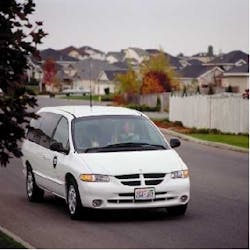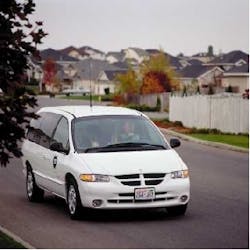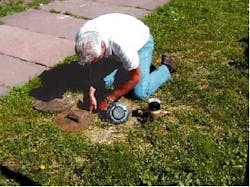Denver Water Looks to the Future New AMR system Will Lower Costs, Improve Customer Service
By Charlie Jordan
Denver Water did not necessarily set out to accomplish the largest Automatic Meter Reading (AMR) implementation in the western United States, but that is indeed the path we are on. And we're confident the project will result in lower costs, increased efficiency, and better customer service for years to come.
Denver Water provides drinking water to more than 1 million people in Denver and its surrounding suburbs. Until now, that meant 33 meter readers driving around town in separate vehicles, walking the neighborhoods, and manually obtaining meter readings - a costly arrangement. "Aside from what's going on in the industry, with utilities going to AMR systems, we just figured out that the way we were doing it, with all of the trucks and the people and the equipment, was too expensive," said Bob Blauvelt, Denver Water's Customer Services Field Manager.
When selecting an AMR solution for our 220,000 residential and commercial meters, we had a pressing need. Since we utilize different brands of meters, we require a system that works with all of them. Otherwise, the system shifts very quickly from a convenience to a compatibility nightmare. After extensive research, we chose Spokane, Washington-based Itron, Inc., as our technology partner. Itron's AMR system works seamlessly with each brand of meter we use.
The key to the AMR system is the device that is installed on the electronic register of existing meters. It is the ERT, or Encoder Receiver Transmitter. When the ERT receives a "wake-up" signal from a handheld, vehicle-based or network reading device, it checks the reading on the meter register, encodes it into a digital signal, and then transmits its identification number and meter reading, which the collection system records. At Denver Water, we've selected a combination of handheld and mobile meter reading technology as the most effective solution to meet our objectives. This technology allows our meter readers to collect readings as they're driving or walking by, never setting foot on the property. At the end of the day, the meter reader simply uploads the information into our billing system. The AMR system also brings durability. As is the case with many western water utilities, most of our meters (80 percent) are pit-set. The ERT is built to withstand such a harsh environment. The remaining meters are located inside buildings and will be fitted with remote-mounted ERTs.
Our current focus is implementing this new technology efficiently. Mass installations began in May of this year, and, by early June, more than 2,500 had been completed. Our goal is to peak at 6,000 installations per month, a pace that would facilitate completion of the project by our target date of June 30, 2005. It is very important through this process for our customers to stay informed, so we've taken a number of steps, including informational notices in water bills, news releases, a bulletin on our website, and letters to affected residents before work is set to begin on their property. A solid distribution partner is also important, and we've found one to perform the installations in Automated System Solutions, of Aurora and Colorado Springs. Their employees wear easily identifiable badges and uniforms during installations, and customers are left with tips for taking care of their new equipment. We also let them know that, barring repair, we won't need to bother them for many years, when we will have to replace the battery in their ERT. So far, people have been receptive and accommodating.
The benefits associated with the AMR system to Denver Water and our customers will become increasingly evident over time. As the project progresses, our fleet of 33 meter readers will be whittled down to a lone meter reader in a single vehicle, a tremendous cost reduction. In addition, a progressively smaller crew will lead to savings on vehicles, communication devices, and workers compensation insurance, as well as reduced liability risks. Between eliminating such hazards as loose dogs, slipping on ice and snow, and climbing over fences, meter reading will become much less dangerous. Training costs will also decline, due to the high turnover rate associated with meter reading. The project is paced at a rate calculated to facilitate employee downsizing through normal attrition. In addition, employees are provided career counselors and support to help them find jobs elsewhere.
Many people assume that new technology and equipment will naturally show up on their bill. That is correct, but in a positive way. The staggered installation schedule, coupled with the immediate cost savings, mean the system will pay for itself as the project progresses. The AMR system should allow us to cut the service charge, a fixed charge built into each bill and currently $2.25 a month, in half.
John Hengesh, vice president and general manager of Itron's Water and Public Power business unit, believes advanced metering technology will be of utmost importance to water utilities such as Denver Water in the future. "We applaud Denver Water's decision to be proactive in recognizing the value of an AMR system, and we're thrilled to work with them," said Hengesh. "We look forward to working together to realize their objectives of improved operational efficiency, reduced costs and increased customer service and satisfaction."
Bills won't only be smaller; they'll also be on a more frequent schedule that people can plan and budget for more easily. With the newfound ease of collecting and processing information comes the ability to switch to a monthly billing cycle in the near future. "Going to monthly billing will be a big convenience for our customers," said Blauvelt. "People are often surprised by the amount of the bill because it only comes once every two months. When we move to monthly billing, they won't have to pay as much on one check." Any time we can take the guesswork out of billing, we are providing better service for our customers. New information gathering systems such as AMR make that possible.
At the heart of this project is a very concerted effort by the Denver Water team to be a leader in the utility industry by innovating and adopting new technologies that reduce costs, increase operational efficiency, and improve the quality of our service. We already get to see that future up close. Our service territory is situated in the midst of the largest operational AMR installation in the world, an Itron system that gathers data from Xcel Energy's 1.5 million electric and gas meters. This confluence of technology could lead to partnership and further cost-saving opportunities down the road.
When Denver Water had completely installed two routes of ERTs, we dispatched a meter reader to read both routes with a handheld meter reading computer equipped with a radio. He was required to walk because we wanted him to pay full attention to his device to avoid reading skips. He finished these routes, which would normally take two people a full day, by 10:30 a.m.
When he returned, he was beaming. "If anyone doesn't think this is a cool system," he smiled, "they don't know meter reading."
About the Author:
Charlie Jordan is Director of Public Affairs at Denver Water.


